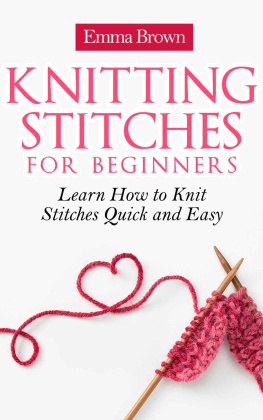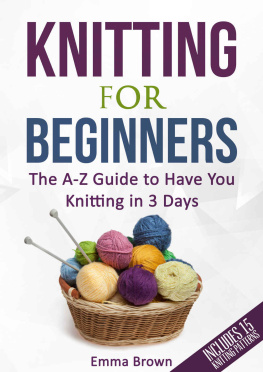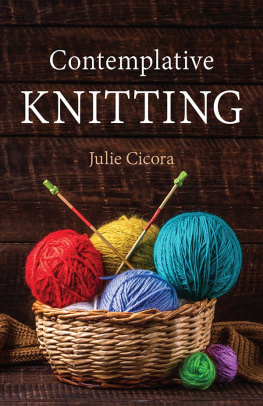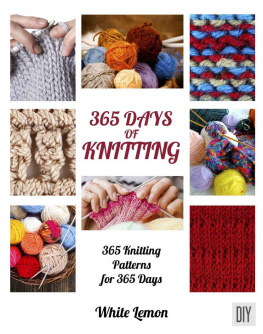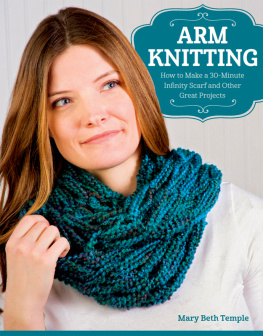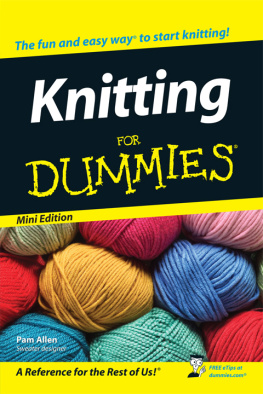
SUSAN B. ANDERSONS
KIDS KNITTING
WORKSHOP

The Easiest and Most
Effective Way to
LEARN TO KNIT!


To my husband and our kids.
Thank you for teaching me so much.


Contents
Introduction
Knitting is for everyone! It really is a craft that boys, girls, kids, teens, and adults of all ages can enjoy. Anyone and everyone can learn to knitall you need are a few simple skills, knitting needles, and yarn, and away you go!
Five Great Things about Knitting
1. Its a social activity. You can knit while you talk or watch TV or movies with family or friends, or even while you are chatting on the phone. Once you get going, you may want to join a knitting group, or teach your friends to knit and form your own group.
2. Its good for your brain. Knitting requires simple counting and math. You have to plan, problem-solve, and think ahead. And once you learn how to knit, it can be very relaxing and calming. Research shows that all of these things are really good for you and your brain!
3. Mistakes are okay! When you first start knitting, you will make mistakes, and thats okay. The more you practice, the better youll get, and the more easily youll be able to figure out why you made the mistake and how to fix it. If you get frustrated, just put your project down and come back to it later. Even a short break can help you figure out what to do next.
4. You can make things that youll actually use and need. Most people need a hat and scarf and mittens to keep warm. Blankets, toys, and pillows, for example, are all useful items. The fact that people can use and appreciate the items you knit for them adds an element of fun!
5. Its portable. You can take your knitting with you when you are on the go. Great places to knit include waiting rooms, sporting events, restaurants (at least until your food comes!), cars, planes, trains, buses, at the parkanywhere youll have some downtime. Of course, always be polite and make sure it is okay with the people around you first.
How to Use This Book
I know that you want to jump right in and start knitting! But before you do, it will help to know a little bit about how this book is organized. is where the fun really startsyoull learn the basics of knitting and try out your new skills on some simple projects. The projects throughout the book are in order from the simplest to more advanced, and youll learn new and trickier skills as you work your way from project to project. At the beginning of each pattern, youll see the materials youll need and the skills youll have to know to create the project.
I recommend reading through . The pattern and lessons will take you step-by-step through the project. This is the case for all of the projectsany new skills you need will be explained in a lesson that appears before the pattern.
Welcome to the world of knittinglets get started!
Teaching Kids to Knit
An Introduction for Adults
In the more than thirty years that I have been a knitter and a knitting instructor, I have taught hundreds of people in person how to knit, and thousands of people through books and videos, including more kids than I can remember. Ive taught my own four children to knit, as well as their friends, entire classrooms of kids, Girl Scout and Brownie troops, and countless kids knitting classes in a local yarn shop. Ive taught kids to knit individually in private lessons, in small groups of two to four, and in large groups of more than twenty (which is not the best!). As you can imagine, I have learned so much along the way about knitting and what works best for teaching it. Some kids learn best from reading directions in books; others from seeing illustrations or videos; and still others from in-person demonstrations. It really depends on the learner. Using a variety of resources usually works best. What I do know for certain is that everyone can learn to knit!
Seven Tips for Teaching Kids to Knit
1. Age ten is the ideal time to learn to knit. Around this age (give or take a year or two), children have developed fine-enough motor skills to learn to knit without getting too frustrated. Also, kids this age often have the perseverance and determination to succeed at a skill like knitting. Of course, there are always exceptionssome kids as young as four years old are able to knit, while others wont learn successfully until they are much older.
2. Having a knitter at home or easy access to a knitter who can help makes a big difference. When a child learns alone, she is more likely to give up. Having someone at home who is a knitter or someone learning to knit at the same time as the child is ideal. This knitter could be a parent, for more on this.
3. Knitting in the round is the easiest and most effective way for children (and adults) to learn how to knit. This is because the new knitter can focus on the simple act of knitting a stitch without any other added challenges. Knitting in the round is repetitive and a good way to practice. All of the projects in this book are knit mainly in the round.
4. Cast on the first few projects for the child (if possible). This way, he can focus just on learning the knit stitch to start. Casting on can be learned after he becomes more comfortable manipulating the yarn and needles.
5. Start with a small-size project. A small-size project (like the ) is achievable in a short amount of time (instant gratification!) and uses very few materials. Starting with a big project like a blanket is not always a good idea, because kids can become overwhelmed or lose interest when they dont see progress in a relatively short amount of time.
6. The smaller the hands, the smaller the materials need to be. If a childs yarn and needles are not the correct size, she wont be comfortable and will get easily frustrated. A medium-weight to bulky-weight yarn and mid-size needles are the perfect place to start. Also, the yarn should be smooth, not super fuzzy or fringed. Highly textured yarns can be fun, but they are more difficult to use and are not ideal for learning.
7. Dont let frustration get you or the child down. If you feel yourself or the child getting frustrated, set the knitting down for a while and come back to it later when you both are fresh and ready to try again. Remember, all mistakes in knitting are fixable! You can pull out the stitches and reuse the same yarn over and over. Many mistakes can be fixed and cleaned up along the way. And I often leave a little mistake in my knitting and think of it as a charming mark of a handcrafted item. There is no room for perfection in the world of homemade things, and thats the best part!


